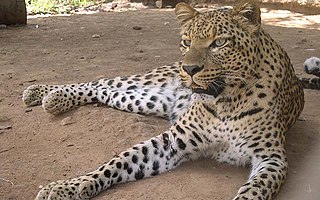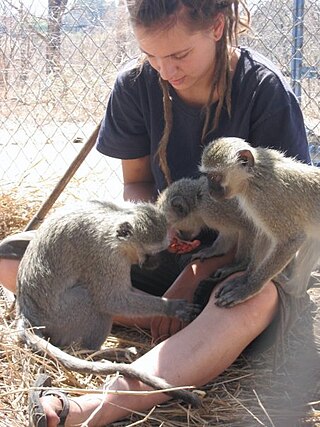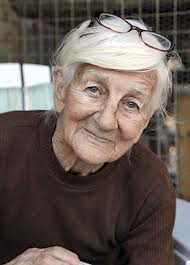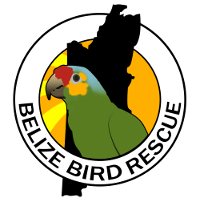This article needs additional citations for verification .(January 2019) |

Wildlife rehabilitation is the treatment and care of injured, orphaned, or sick wild animals so that they can be released back to the wild.
This article needs additional citations for verification .(January 2019) |

Wildlife rehabilitation is the treatment and care of injured, orphaned, or sick wild animals so that they can be released back to the wild.


Rehabilitation begins when an animal is found and reported to a wildlife rehabilitator, or seized from the illegal wildlife trade or a poacher. If you find wildlife in need of rescue, it can be dangerous or even illegal to interact with the animal yourself; be sure to contact a licensed rehabilitator before taking action.
The rehabilitator will examine the animal to determine the extent of the injury and the probability of successful rehabilitation. If it appears that the animal can make a sufficient recovery to be able to return to the wild, the animal will be fed, nurtured, provided safe temporary housing, and medically treated as necessary.
Animals that cannot be rehabilitated are usually euthanized humanely, although animals are occasionally placed at facilities appropriately licensed for educational exhibit or brought into appropriate lifetime care in a wildlife rescue center.
The goal of wildlife rehabilitation is to safely return the animal back to its home, but this is not always the case. A non-releasable animal may sometimes be kept by the rehabilitator (under separate permit) as a surrogate parent for orphaned or injured young wildlife.
Preventing imprinting and habituation is important in the rehabilitation process. Imprinting occurs when a young animal, specifically young birds, begin to see the rehabilitator as their primary caregiver. [1] It is possible to reverse this process in most animals, but it is permanent with birds. Rehabilitators have to take caution when caring for young animals in order to avoid this. It is critical to establish maintain boundaries between the rehabilitator and the animal. This includes wearing a mask and gloves around animals or even covering an animal's cage with a towel to prevent contact with humans. [2]
The field of wildlife rehabilitation varies from small scale operations of individuals working from their homes, usually working with a veterinarian; to professionally staffed wildlife hospitals. Some organizations are teaching wildlife hospitals: Tristate Bird Rescue, Paws Wildlife Center, the Wildlife Center of Virginia, and The Clinic for Rehabilitation of Wildlife provide training to veterinary students from around the world, and offer one-year postdoctoral internships in clinical wildlife medicine. Other facilities are affiliated with universities, such as the Amos Rehabilitation Keep (ARK) at the University of Texas Marine Science Institute.
Another type of wildlife rehabilitator is the Senkwekwe Centre in Virunga National Park in the Democratic Republic of Congo, which cares for the only two orphan baby mountain gorillas in captivity. Their rescue and subsequent survival is considered an important contribution to the conservation of a critically endangered species.
Many wildlife rehabilitators and centers are also committed to improving the well-being of wildlife though public education; focusing on how humans can safely and peacefully coexist with native wildlife, and on wildlife's importance to humans and the environment. Wildlife rehabilitation clinics can also often offer advice and guidance on humane solutions for "nuisance" wildlife concerns. [3]
In many countries, including the United States and Australia, wildlife rehabilitation requires a license and/or permit. In these countries, it is against the law to rehabilitate (or in some cases possess) a wild animal without permits. In the United States, rehabilitation permits, requirements, and procedures for all animals other than birds vary from state to state.
Rehabilitation of birds in the U.S. requires, per the Migratory Bird Treaty Act, that a permit be obtained from both the state wildlife agency and the United States Fish and Wildlife Service. The only birds rehabilitators can admit without a federal permit are common birds considered to be introduced invasive species: rock doves, European starlings, and house sparrows; although some licensed rehabilitation facilities cannot accept introduced species as a condition of their licensing. [4]
There a number of regulations in place when it comes to wildlife rehabilitation. States require a license in order to work as a wildlife rehabilitator. In certain states, such as North Dakota, you must be a licensed veterinarian if you want to work in wildlife rehabilitation. Rehabbers must go through a lot of training before they obtain their wildlife rehabilitation license. [5]
The Born Free Foundation is an international wildlife charity that campaigns to "Keep Wildlife in the Wild". It protects wild animals in their natural habitat, campaigns against the keeping of wild animals in captivity and rescues wild animals in need. It also promotes compassionate conservation, which takes into account the welfare of individual animals in conservation initiatives. Born Free also creates and provides educational materials and activities that reflect the charity's values.
Tri-State Bird Rescue and Research, Inc. is a nonprofit conservation organization in Newark, Delaware, dedicated to indigenous wild bird rehabilitation, especially rehabilitation efforts related to oil spills. It is notable for its research and rehabilitation efforts concerning wildlife affected by oil spills, which have been international in scope.

The Cascades Raptor Center is a nature center and wildlife hospital in Eugene, Oregon that specializes in raptor rehabilitation. As of November 2020, permanent inhabitants of the center include 37 individual birds from 21 species.

The Alabama Wildlife Center is a wildlife rehabilitation and education center located in Oak Mountain State Park in Pelham, Alabama, United States. It is the largest and oldest rehabilitation center in the state.

Chipangali Wildlife Orphanage is a not-for-profit organisation dedicated to the rescue and care of orphaned, injured, abandoned, abused or confiscated wild animals in southern Africa. It is located in Bulawayo, Zimbabwe.

The Raptor Trust is a wild bird rehabilitation center located in the Millington section of Long Hill Township in Morris County, New Jersey, United States, and surrounded by the Great Swamp National Wildlife Refuge.

The Bird Alliance of Oregon (formerly Portland Audubon) is a non-profit environmental organization dedicated to bird and habitat protection across Oregon in the United States.

The Vervet Monkey Foundation (VMF) is a 23-hectare not-for-profit centre for rehabilitation, education and sanctuary for vervet monkeys, near the town of Tzaneen, South Africa. Registered and established in 1993, it is situated approximately 80 miles south of the Tropic of Capricorn. The sanctuary is a member of the Pan African Sanctuary Alliance (PASA), and the Global Federation of Animal Sanctuaries (GFAS). The foundation relies heavily on volunteer workers primarily from western countries to assist in the day-to-day running and care duties of the foundation.

International Animal Rescue (IAR) is an animal protection and conservation non-profit organisation that comes to the aid of suffering animals with hands-on rescue and rehabilitation and the protection of wildlife habitats. IAR returns rehabilitated animals to the wild while also providing permanent sanctuary for those that cannot fend for themselves. Its work includes cutting free and caring for captive bears in India and Armenia, rescuing and rehabilitating orangutans and other primates in Indonesia and treating injured and orphaned howler monkeys in Costa Rica. IAR strives to educate the public in the humane treatment of all animals and the preservation of the natural environment. International Animal Rescue has offices in the United Kingdom, United States, [[India]
Humane Animal Rescue of Pittsburgh (HARP), formerly known as the Animal Rescue League of Western Pennsylvania, known commonly as Animal Rescue League Shelter & Wildlife Center (ARL), is an animal welfare organization founded in Pittsburgh, Pennsylvania, in 1909. The ARL is a non-profit organization that offers various services to support both animals and pet owners alike. It is the only animal shelter in the Pittsburgh area that accepts both domestic animals and wildlife. The agency's shelter and clinic are located in Pittsburgh's East Liberty neighborhood, while its wildlife rehabilitation center and boarding kennels are a few miles away in Verona, Pennsylvania. The organization maintains a contract with the city of Pittsburgh and accepts all stray pets that are apprehended by the Animal Control unit.

The Juneau Raptor Center (JRC) was a raptor rehabilitation center in Juneau in the U.S. state of Alaska. Founded in 1987 and located in the Tongass National Forest, its mission was the rehabilitation of sick and injured eagles, hawks, falcons, owls, ravens, hummingbirds and other avian wildlife brought in from Juneau and Southeast Alaska. The JRC was licensed by the US Fish and Wildlife Service to handle eagles and migratory birds, and was governed in part by the Bald and Golden Eagle Protection Act and the Migratory Bird Treaty Act of 1918.

Rita Miljo was a South African conservationist and animal rights pioneer noted for founding and managing the "Centre for Animal Rehabilitation and Education" (CARE) near Phalaborwa in South Africa. Born in East Prussia shortly before World War II began, she had dreams from an early age of becoming a veterinarian. When the war broke out, she became involved in the girls' wing of the Hitler Youth, but quit when her father no longer supported the Nazis. After a brief stint studying psychology in university, she worked in a factory and then at the Hagenbeck Zoo.
Care for the Wild International is an animal charity, a non-governmental organization established in 1984 and based in the United Kingdom. It supports wildlife projects and it campaigns on animal rights issues in Britain and around the world.

Hope for Wildlife (HFW) is a non-profit wildlife rehabilitation and education centre located on a farm in Seaforth, Halifax Nova Scotia, Canada. It was founded by Hope Swinimer in 1997 as The Eastern Shore Wildlife Rehabilitation and Rescue Centre. It got its current name in 2005. A television series, Hope for Wildlife, began documenting the centre's efforts in 2009.

Belize Bird Rescue (BBR) is an avian rescue and rehabilitation centre in Belize.
The Yellowstone Wildlife Sanctuary is the 501(c)(3) nonprofit animal sanctuary in Red Lodge, Montana, with the mission of providing lifelong sanctuary to non-releasable Greater Yellowstone Ecosystem wildlife while sharing a message of education and conservation. The Yellowstone Wildlife Sanctuary is accredited by the American Sanctuary Association.
The Wild Bird Fund is a non-profit animal hospital on the Upper West Side of Manhattan in New York City. It is the city's first and only wild animal hospital.

WA Wildlife, operated by Native ARC Inc, is a wildlife rescue, treatment and rehabilitation facility in the Beeliar Wetlands near Bibra Lake, Western Australia; it was the first wildlife rehabilitation facility to be licensed as a veterinary hospital by the Veterinary Practice Board of Western Australia in 2018. It has a purpose built hospital to care for the animals, with intensive care unit facilities to care for animals that would have previously been euthanised. The hospital provides treatment to more than 6500 sick and injured native animals each year. Facilities include a triage room, treatment room, consultation room, laboratory, surgery, radiology, ICU, seabird, mammal and reptile wards, isolation ward with decontamination chamber and a stand-alone necropsy suite. WA Wildlife is part of group of organisations helping to protect the nests of the snake-necked turtles that breed around Bibra Lake. In 2020 it was estimated that 25 of the hatchlings were able to make it to the safety of the lake. Native Arc Inc is a registered charity, number 21503, licensed under the Charitable Collections Act 1946.
The Wildlife Rescue Association of BC(WRA) is a wildlife rescue and rehabilitation centre based in Burnaby, British Columbia, Canada, that is permitted to care for injured, orphaned, and pollution-damaged wildlife in British Columbia. It is a member of the Wildlife Rehabilitators' Network of British Columbia (WRNBC).
This article's use of external links may not follow Wikipedia's policies or guidelines.(June 2020) |